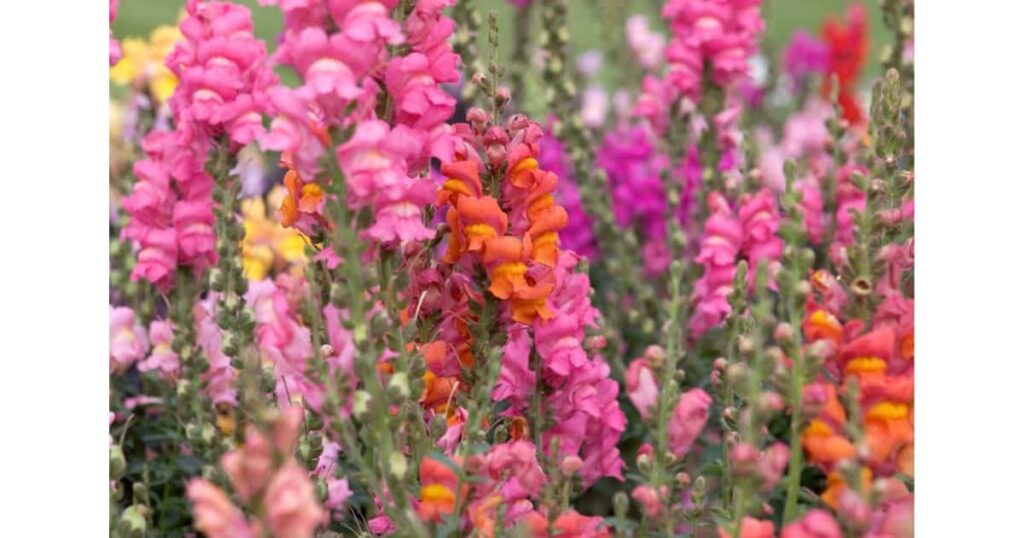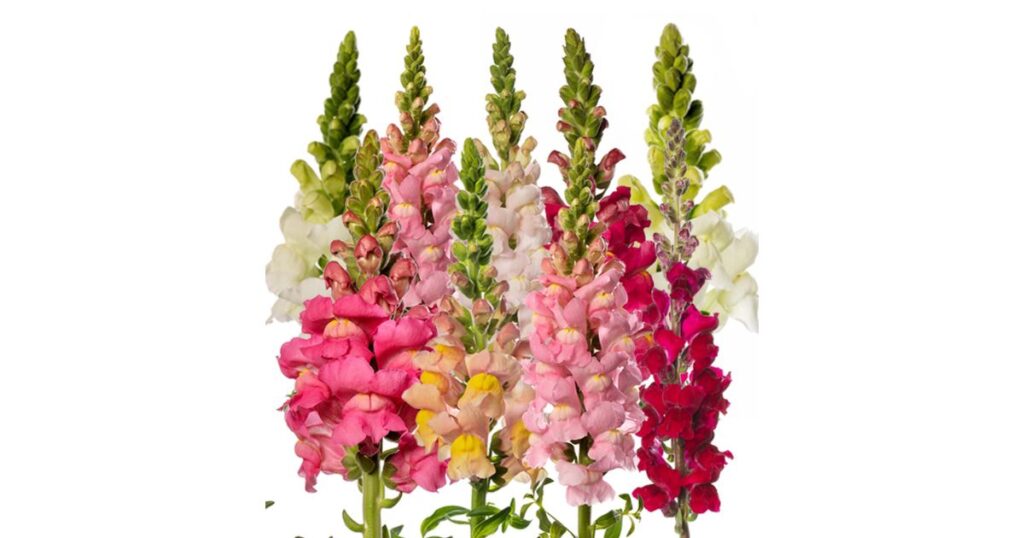Are you hoping to give your yard or floral arrangements a pop of brilliant color? Look no further than Antirrhinum Majus’ pink snapdragon blossoms. These vibrantly colored blooms are a joy for any gardening enthusiast or flower lover with their remarkable beauty and alluring charm.This article will cover how to grow, take care of, and enjoy pink snapdragons, as well as suggestions for extending their vase life and making them suitable for great-cut flowers.
Pink Snapdragon Flowers in Bloom
Pink snapdragons are a great choice for both novice and seasoned gardeners because they are reasonably simple to grow. To grow these beautiful plants successfully, keep in mind the following points:
Hardiness and Blooming Season:
Pink snapdragons bloom most frequently in the early spring, spring, and autumn. They can withstand temperatures as low as 32°F (0.0°C). It also enables you to take pleasure in their lovely blooms throughout various seasons.
Plant habit and size
Pink snapdragons have an erect, mounded growth habit and grow to a height of 6 to 10 inches (15 to 25 cm) and a width of 10 to 12 inches (25 to 30 cm). Due to their small size, they can be used as borders, containers, or even bordering plants in gardens.
Exposure and Watering:
Pink snapdragons require at least six hours of daily direct sunlight to grow. Make careful to water them frequently, keeping the soil equally moist without waterlogging, as they require medium watering levels.
Fertilizing and Spacing:
Feed your pink snapdragons with a balanced fertilizer every two weeks to encourage strong growth and copious flowering. Plants should be placed about 10 to 12 inches (25 to 30 cm) apart to allow for adequate airflow and avoid crowding.
How to Take Care of Pink Snapdragons

Pink snapdragons are renowned for requiring little upkeep. However, a little attention may go a long way in ensuring blooms that are healthy and last a long time:
Attracting Hummingbirds and Bees:
Pink snapdragons have fragrant blossoms that draw hummingbirds and bees to your garden, promoting a healthy ecology. Enjoy these beneficial pollinators’ pleasant presence as they visit your snapdragon blooms.
Cutting Stems and Vase Life:
Pink snapdragons make excellent cut flowers, ideal for bringing a touch of sophistication to your floral arrangements. Cut stems early in the morning or late in the day and put them right away in a pail of water. Change the water every two days to extend their vase life, which might be between 7 and 10 days.
Snapdragon Rocket Pink:
This pink snapdragon variation is one that deserves special mention. This cultivar has stunning, tightly packed flower spikes in colors of pink and an astonishing height of up to 36 inches (91 cm). Think about introducing Snapdragon Rocket Pink into your landscape for a magnificent vertical display.
Pink Snapdragon Flower Pruning and Deadheading Instructions
It’s wonderful to have savannah flowers in your garden, especially the pink varieties that lend an air of romance and charm. However, you must frequently prune and deadhead them if you want to keep them blooming for a long time.
Simple gardening operations like pruning and deadheading can significantly impact the health and beauty of your snapdragon plants. This is how you do it:
Pruning:
Pruning is the removal of undesirable or harmed plant parts, such as sickly or dead stems, leaves, or flowers. Pruning aids in shaping the plant, enhancing airflow, and preventing illness. It is advisable to prune snapdragons in the early spring before they begin to bloom.
When pruning your snapdragons, use clean, sharp pruners to trim any weak or lanky stems to roughly half their original length. The plant will be encouraged to grow additional branches and blossoms as a result. To encourage bushier plants, you can also clip the stem tips back by about an inch, right above the following set of genuine leaves.
Deadheading:
By removing fading or gone blossoms from the plant, you can stop them from setting seed. This practice is known as “deadheading.” By directing the plant’s energy into generating more blooms rather than seeds, deadheading helps to extend the flowering season.
Additionally, it keeps the plant neat and appealing. It’s preferable to deadhead snapdragons on a regular basis, once or twice a week, throughout the blooming period. Use clean pruners or scissors to gently cut the flower stem below the blossom on your snapdragons in order to deadhead them. You can pinch the blossoms off with your fingers if they are soft enough.
Put the deadheads in a garbage or compost container for disposal. However, you can keep some of the blossoms on your preferred snapdragon plants until they are completely dry and brown if you want to conserve some seeds for the next year.
By following these easy instructions, you can prune and deadhead your pink snapdragon flowers and appreciate their beauty for a long time. Additionally, you can cut some of the fresh flowers to make a stunning bouquet or arrangement indoors.
Instructions for Growing Pink Snapdragon Flowers from Cuttings or Seeds

Pink snapdragon flowers are a wonderful addition to any garden with delicate, fragrant blossoms that draw bees and butterflies. You may grow more of these adorable plants by starting with seeds or cuttings. The steps to take for each technique are listed below:
Seeds
If you live in USDA Hardiness Zones 7 to 10, you can start snapdragon seeds eight to ten weeks before the final date for frost in your location, or you can directly sow them in the garden in the autumn or spring. Select a sunny area, then prepare the soil by aerating it and incorporating compost. Seeds need light to germinate, moisten the soil, and scatter the seeds over the top.
Keep the soil moist but not waterlogged until the seeds sprout, which can take two to three weeks. When the seedlings have two sets of genuine leaves, thin them to six to twelve inches apart.
Cuttings
Snapdragons can also be multiplied by taking stem cuttings from a thriving parent plant. Remove the lower leaves by cutting a two-inch portion of the stem directly below a leaf node. Insert the cutting into a pot with moist, sterile, soilless potting mix after dipping the bottom of it in rooting hormone.
A different option is to put the cutting in a jar of water and change the water every few days. Maintain humidity by misting the cutting frequently in an area with bright but indirect light. It should take the cutting between four and six weeks to root.
You can transplant your snapdragon plants to your garden or containers once they have a strong root system. Pick a location with good, well-drained soil that receives either full sun or light shade. When it’s hot and dry, make sure to water them frequently and fertilize them once a month with a balanced fertilizer. Enjoy your pink snapdragon flowers for a long time by deadheading the spent flowers to promote more blooming.
Conclusion
Pink snapdragon flowers give your yard and floral arrangements a bright, fresh appearance. You may successfully cultivate and care for these lovely blossoms by adhering to the straightforward instructions in this tutorial. Pink snapdragons’ vividly colored petals make them visually appealing and draw bees and hummingbirds, creating a peaceful setting.
Additionally, they are preferred for making gorgeous bouquets due to their long vase life and appropriateness as great-cut flowers. Don’t pass up the allure of Snapdragon Rocket Pink, a variety that gives your yard a vertical emphasis. Enjoy the alluring presence of pink snapdragons in your gardening endeavors and embrace their beauty.
Frequently Asked Questions
Q. What pink snapdragon flower kinds are best for growing?
Depending on your preferences and available garden space, you can choose from a wide variety of pink snapdragon blooms. Popular varieties include Snapdragon Rocket Pink, which has tall, thick flower spikes; Snapdragon Chantilly Pink, which has fragrant, butterfly-shaped blooms; and Snapdragon Magic Carpet Pink, a dwarf version that is great for planting along borders or as an edging.
Q. How can I keep my pink snapdragon blooms from contracting rust disease?
The fungus rust disease causes the orange or yellow patches on the leaves and stems of snapdragons. If left untreated, it might weaken the plants’ vigor and blossoming and eventually kill them.
Avoid overhead watering, give your plants plenty of room to breathe by spacing them widely apart, and get rid of any infected plant portions to prevent rust disease. If you see any rust indications, you can spray your plants with a fungicide containing copper.
Q. How can I make cut flower arrangements using pink snapdragon flowers?
Pink snapdragon flowers offer vibrant, long-lasting blooms, making them excellent cut flowers. Cut the stems at an angle early in the morning or late in the day when they are fully hydrated to use them for cut flower arrangements. Remove any leaves or foliage that will be submerged in the water before placing them in a bucket of water.
To keep them fresh, change the water every two days. To increase the vase’s life, add sugar or flower preservatives. Additionally, you may combine them to make gorgeous bouquets or arrangements with other flowers or grasses.


